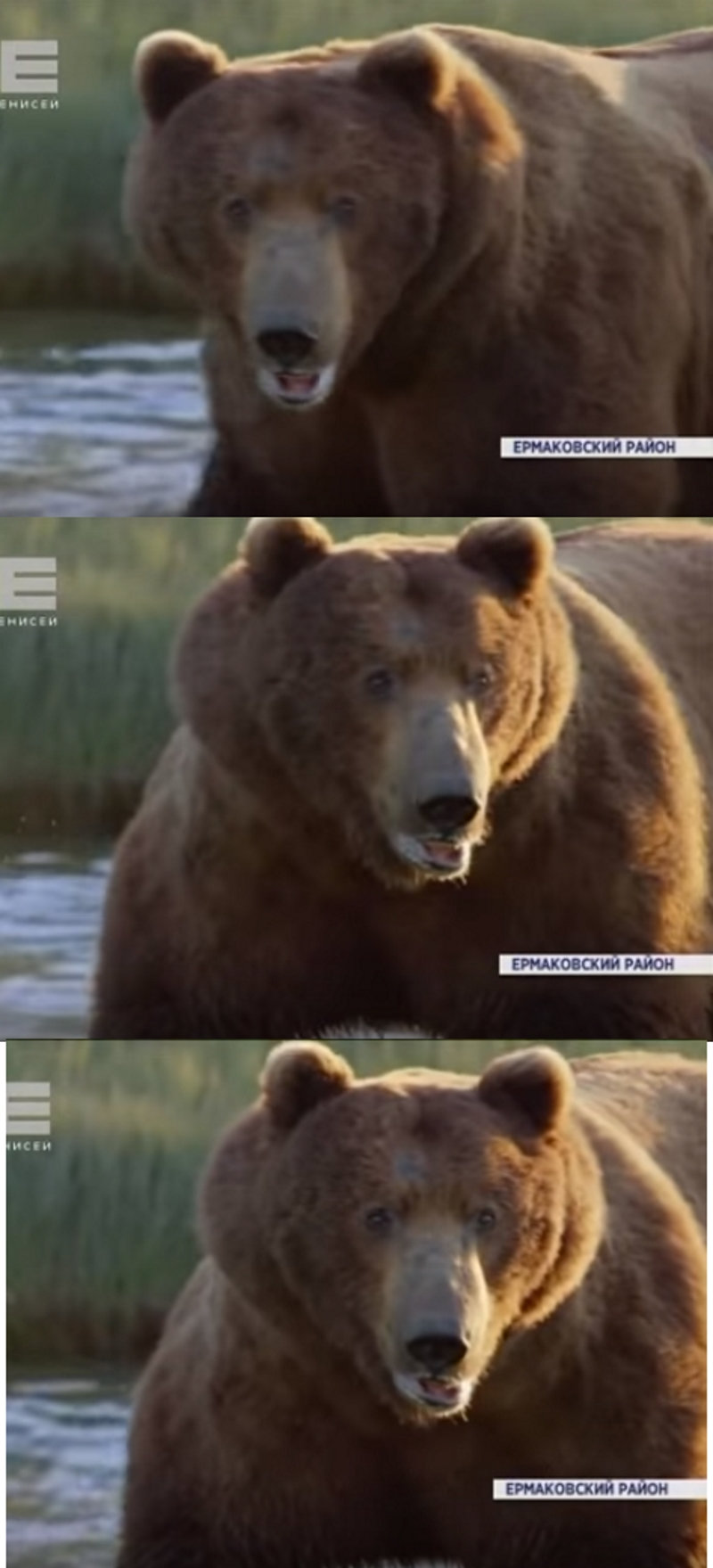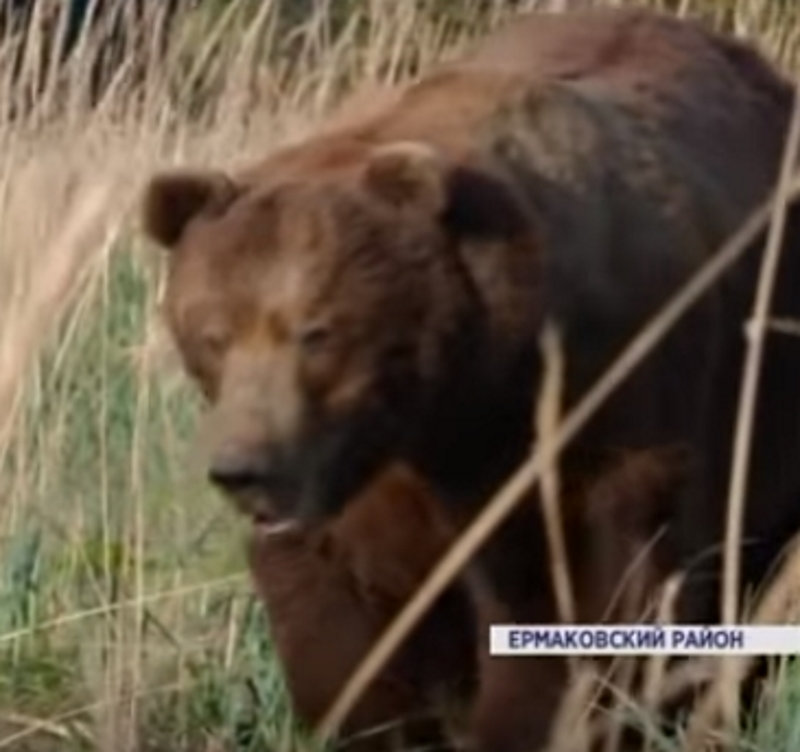|
|
Post by Gorilla king on Jul 22, 2021 9:26:25 GMT -5
East Siberian brown bear
The East Siberian brown bear (Ursus arctos collaris) is a population or subspecies of brown bear which ranges from eastern Siberia, beginning at the Yenisei river, north to the Arctic Circle, as far as Trans-Baikaliya, the Stanovoy Range, the Lena River, Kolyma and generally throughout Yakutia and the Altai Mountains. The subspecies is also present in northern Mongolia.[1]

Brown bear with slaty-backed gulls at Magadan Nature Reserve, Russia
Size
East Siberian bears are intermediate in size to Eurasian brown bears and Kamchatka brown bears, though large individuals can attain the size of the latter. Their skulls are invariably larger than those of Eurasian brown bears and are apparently larger than those of Kamchatka brown bears.[1] Adult males have skulls measuring 32.6–43.1 cm (12.8–17.0 in) in length, and 31.2–38.5 cm (12.3–15.2 in) wide at the zygomatic arches. They have long, dense and soft fur which is similar in colour to that of Eurasian brown bears, though darker coloured individuals predominate.
Taxonomic history

Originally, Cuvier's trinomial definition for this subspecies was limited to brown bear populations in the upper Yenisei river, in response to bears there sporting well-developed white collars. The subspecies has since been reclassified as encompassing populations formerly classed as jeniseensis and sibiricus, though the latter two lack the collar.[1]
Behaviour and ecology
Bear at a campsite in the Sakha Republic
Siberian bears tend to be much bolder toward humans than their shyer, more persecuted European counterparts. Siberian bears regularly destroy hunters' storages and huts where there is food.[2] They are also more carnivorous than their European counterparts and do not seem to like honey. They hunt mountain hares and ungulates such as reindeer, wapiti or moose by ambushing them from pine trees.[3]
en.m.wikipedia.org/wiki/East_Siberian_brown_bear
|
|
|
|
Post by Gorilla king on Jul 22, 2021 9:31:32 GMT -5
East Siberian brown bear
 
East Siberian brown bears (Bear Conservation – Creative Commons Licence)
Accepted scientific name: Ursus arctos collaris (Frédéric Georges Cuvier, 1824)
Description: Smaller than Kamchatka brown bears (U. a. beringianus) but larger than Eurasian brown bears (U. a. arctos) with long and dense fur, usually dark but varies from pale brown through cinnamon to dark brown. Some bears (the upper Yenisei River population) have white collars, hence their Latin name.
Range: Eastern Siberia from the River Yenisei to the Altai Mountains. Also found in northern Mongolia, far northern Xinjiang in China, and in extreme eastern Kazakhstan. Not present in the habitat areas of the Kamchatka (U. a. beringianus) and Ussuri or Amur (U. a. lasiotus) brown bears.

Habitat: The Taiga, (boreal forest), of the Altai Mountains and the numerous valleys of the region. The forests are coniferous, consisting mostly of pines, spruces and larches.
Status: Russia has the largest black bear population in the world. The brown bears of East Siberia are populous but, nonetheless, are considered to be endangered as they are still largely treated as a game animal. Around 5,000 bears in the Altai Mountains and over 16,000 in the East Siberian Taiga. Other population figures not known.
Life span: Assumed to be around 20 to 30 years in the wild.
Food: More carnivorous than European brown bears, will take mammals ranging in size from hares up to caribou (reindeer) and elk. Known to raid hunters’ food stores and huts for food. Data on diet is sparse but, in common with other brown bears, will eat a wide variety of vegetation, seeds, nuts, fruit, roots and tubers, small mammals, carrion and fish.
Behaviour: Information on this subspecies is sparse. The bears build winter dens and typically will occupy these from October or November until late March, April or early May. Mating takes place between May and July and the cubs, usually two or three, are born in the den in January or February. They will remain with the mother for around two and a half years during which time she will not become pregnant again. Except for during mating and for mothers with cubs the bears are solitary.
Threats: Hunting, conflict with humans, mainly due to habitat loss (particularly due to the clear-cutting of forests), and ,increasingly, poaching on a commercial scale to obtain gall bladders and other body parts for use in medicine.
MORE INFORMATION
Ursus arctos collaris now encompasses four other previously separately classified subspecies; sibiricus (Siberia), jeniseensis (Krasnoyarsk region), kolymensis (Kolyma River), and baikalensis (Irkutsk region).
The brown bears of the Kolyma and Anadyr basins are included in this subspecies but they are similar to the arctic grizzlies of North America, being relatively small and long-haired. Some authorities believe that they should be classified as a further, separate subspecies.
www.bearconservation.org.uk/east-siberian-brown-bear/
|
|
|
|
Post by Gorilla king on Jul 22, 2021 9:38:07 GMT -5
MEASUREMENTS AND WEIGHTS OF ADULT MALE BROWN BEARS IN NORTH-EASTERN SIBERIA (URSUS ARCTOS COLLARIS)

BASED ON THE 10 SPECIMENS WITH THE WEIGHTS LISTED, THE AVERAGE FOR THIS SUBSPECIES IS 231 KG (509 LBS)
|
|
|
|
Post by Gorilla king on Jul 22, 2021 9:43:12 GMT -5
EAST SIBERIAN BROWN BEAR (URSUS ARCTOS COLLARIS)


|
|
|
|
Post by Montezuma on Apr 9, 2022 20:33:35 GMT -5
|
|
|
|
Post by Gorilla king on Apr 9, 2022 22:42:22 GMT -5
Reply #4, that is a very nice account bro. When the book was written in 1865, there were tigers in Eastern Siberia. Now they are most likely extinct in that region.
|
|
|
|
Post by oldcyansilverback on Apr 10, 2022 6:55:43 GMT -5
This brown bear subspecies seems to have entered the article circle too. Perhaps they may have encountered polar bears ?
This bear might have a similar temperament to the Ussuri brown bear.
|
|
|
|
Post by Gorilla king on May 2, 2022 19:38:46 GMT -5
EAST SIBERIAN BROWN BEAR:

|
|
|
|
Post by oldcyansilverback on Jun 3, 2022 18:19:34 GMT -5
/\ Judging from that picture above, this specimen is a huge male. Since the photo is not coloured, this bear must have already passed away.
|
|
|
|
Post by Gorilla king on Jul 11, 2022 19:44:20 GMT -5
|
|
|
|
Post by oldcyansilverback on Jul 11, 2022 20:06:46 GMT -5
While not as agile as big cats, brown bears are more agile than people give credit for.
|
|
|
|
Post by Gorilla king on Jul 20, 2022 16:58:44 GMT -5
|
|
|
|
Post by Gorilla king on Jul 21, 2022 21:56:31 GMT -5
This brown bear subspecies seems to have entered the article circle too. Perhaps they may have encountered polar bears ? This bear might have a similar temperament to the Ussuri brown bear.
(does not state which subspecies although the East Siberian brown bear is the only subspecies able to reach Wrangel Island, Russia, as its the Northernmost and closest subspecies to Wrangel Island).
24 March 2022
First evidence of a brown bear on Wrangel Island, Russia
Abstract
We report the first photographic and genetic evidence of a brown bear (Ursus arctos) on Wrangel Island, Russia, located north of 71° in the Arctic Ocean. The sequenced control region (D-loop) of mitochondrial DNA obtained from hair of a sighted bear was indistinguishable from one of the most widespread haplotypes of the Eurasian brown bear. Molecular genetic analysis indicated that the bear was male. We photographed what may have been a second brown bear on a remote camera trap. It is unknown whether the bear(s) were transients or indicative of a range expansion associated with warming temperatures. Wrangel Island currently supports muskoxen (Ovibos moschatus), reindeer (Rangifer tarandus), and several top predators including a high density of polar bears (Ursus maritimus) during the summer and autumn. Thus, the presence of brown bears could lead to novel interspecies interactions with potentially cascading ecological effects.


bioone.org/journals/ursus/volume-2022/issue-33e4/URSUS-D-20-00024.1/First-evidence-of-a-brown-bear-on-Wrangel-Island-Russia/10.2192/URSUS-D-20-00024.1.full#:~:text=At%20least%20one%20brown%20bear
|
|
|
|
Post by Gorilla king on Aug 6, 2024 18:54:40 GMT -5
"...During drought years in the eastern portions of Russia, low precipitation resulted in poor forage production and increased bear-human conflicts. When these conditions exist, bears in poor physical condition approach settlements.and prey on livestock and humans.During 1962, one of the worst bear food years on record, 767 brown bears were shot in Tuva (south-central Siberia) and >200 died due to cannibalism by other bears. Wildlife officials estimated about 67% of the population was eliminated from this region in 1 year (Zyryanov and Smimov 1992)."
www.jstor.org/stable/3872673
|
|
|
|
Post by Gorilla king on Sept 20, 2024 20:58:43 GMT -5
|
|
|
|
Post by oldcyansilverback on Sept 20, 2024 23:53:47 GMT -5
Reply 12. There is a possibly they could have encountered polar bears at some stage in their life.
|
|



















